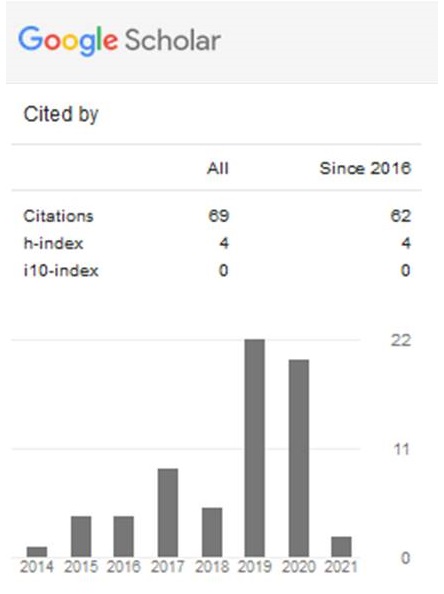Correlation between Development Characters of Oil Palm Bunch (Elaeis guineensis Jacq) with Yield Component and Days to Harvest
Abstract
This study aims to determine the pattern of oil palm bunches development and look at the fat composition at various stages of bunch development which will later be used as criteria for determining the most appropriate bunch harvest time in oil palm plants. This research was conducted by field survey on 7-year-old oil palm plants. A total of 90 plants whose female flowers were in bloom were selected from the experimental garden to ensure that the initial bunch development started at the same time. Sampling of bunches was carried out every 15 days starting at 30 days after pollination (HSP), then after 120 HSP samples were taken every 5 days until the bunch was 180 HSPso that 20 sample points were obtained. Observations made included bunch analysis, fruit analysis and fruit fat analysis. The results showed that the observed variable values tended to increase according to age and bunch development and decreased slightly after reaching the maximum value. The pattern of development of bunch weight and dry weight of oil palm bunch was inversely correlated with fruit moisture content. Mesocarp total fat content of oil palm fruit at the age of 30 HSP was still very low but increased until the age of 170 HSP. Meanwhile, free fatty acid levels began to exist at the age of 75 HSP and continued to increase at the age of 185 HSP. All parameters observed were positively correlated with each other, except for the water content of the fruit, which had a negative correlation. Bunch development reached its maximum point when the fruit was 170-175 HSP. Therefore, when this sample can be used as a reference for the right harvest time for oil palm plants.
Keywords
Full Text:
PDFReferences
Aziz, A.A. 1990. A simple floatation technique to gauge ripeness and BPM LPP 2000. Balai Penelitian Marihat. Pematang Siantar. Sumatera
Do, E. 2002. Palm oil: biochemical, physiological, nutritional, hematological, and toxicological aspects: a review.Plant Foods Hum Nutr. Fall/57(3-4):319-41.
Fauzi, Y., Widyastuty, Y.,E. Setyawibawa, I., Hartono, R. 2007. Kelapa Sawit. Penebar Swadaya. Jakarta.
Flingoh C.O. dan K Zukarinah. 1989. Measurement Palm Oil Content by Nuclear Magnetic resonance spectroscopy. International Palm Oil Development Confrence, Kuala Lumpur : 238-241.
Harahap, R.H. 2008. Respon Bibit Kelapa Sawit (Elaeis guineensis jacq) Pada Pemberian Pupuk An-Organik Dan Organik Sintetis Di Pembibitan Utama. Skripsi. Fakultas Pertanian Universitas Riau. Pekanbaru.
Hartley, C.W.S.1976. The Oil Palm. Longmans. London.
Ikemefuna dan Adamson (1984). Phenology, growth and physiological adjustments of oil palm to sink limitation induced by fruit pruning. Annals of Botany. 104: 1183-1194.
Jumidi. 2007. Hubungan antara tinggi tanaman varietas kelapa sawit (Elaeis guineensis Jacq) dengan kualitas tandan. Tesis program Pascasarjana. Universitas Sumatra Utara. Medan.
Lubis ,A .U. 1992. Kelapa Sawit ( Elaeis guinensis,Jacq ) Di Indonesia. Pusat Penelitian Perkebunan Marihat. Sumatera Utara.
Lubis A. U. 2008. Kelapa sawit di Indonesia. Pusat Penelitian Perkebunan Marihat Pematang Siantar. Sumatra Utara.
Murphy, D.J. 2009. Oil palm : Future prospects for yield and quality improvements. Lipid Technol. 21 : 257-260.
Nikolaos, B.K. dan K. Theophanis. 2000. Calculation of iodine value from measurement of fatty acid methyl esters of some oils: Comparison with the relevant americam Oil Chemists Society Method. JAOCS. 77 (12) : 1235-1238.
Nurdin S. 2000. Perubahan mutu buah sawit segar akibat penyinaran, temperatur, kelembaban selama ditempat pengumpulan hasil. Tesis program Pascasarjana. Universitas Sumatera Utara. Medan.
Oil Development Confrence, Kuala Lumpur. 87-91
Prayogi, A. 2016. Studi mutu buah kelapa sawit (Elaeis guineensis Jacq.) pada berbagai umur tanaman di lahan gambut. Skripsi. Universitas Riau. Pekanbaru.
PTPN III. 2003. Vademecum Budidaya Kelapa Sawit PTPN Press. Sumatera Utara.
Purba, I.R, Irsal dan Meiriani. 2017. Hubungan fraksi kematangan buah dan ketinggian tandan terhadap jumlah buah memberondol pada panen kelapa sawit (Elaeis mguineensis Jacq) di Kebun Rambutan PTPN III. Jurnal Agroekoteknologi FP USU. Vol.5.No.2, April 2017 (41): 315- 328.
Rasyad, A., D.A. Van Sanford dan D.M. Tekrony. 1990. Chanes in seed viability and vigor during wheat seed maturation. J. Seed Sci. and Technol. 18 : 259-267.
Razali, M.H., A.S.M.A. Halim, S. Roslan. 2012. A Review on crop plant production and ripeness forecasting. IJACS. 4(2):54-63.
Sambanthamurthi, E.M.A, H.A. Sani, A. Abdullah dan Z.M. Kasim. 2000. Fatty acids composition of four different vegetable oils (Red palm olein, corn oil and coconut oil) by gas chromatography. Proseding Second International Conference on Chemistry and Chemical Engineering. Singapore: 31-34.
Simanjuntak S.B. 1994. Daya saing dan prospek daya saing hasil kelapa sawit di pasar Internasional. Perhepi Komda Sumut. Medan.
Sunarko. 2009. Budidaya dan Pengelolaan Kebun Kelapa Sawit dengan Sistem Kemitraan. Agro Media. Jakarta.
Tranbarger, T.J; S. Dussert, T. Joet, X Agout, M. Summo, A. Champion, D. Cros, A. Omore B. Nouy,and F. Morcillo. 2011. Regulatory mechanisms underlying oil palm fruit. mesocarp maturation, ripening and functional specialization in lipid and caretonoid metabolism. Plant Physiol. 156:564-584.
Yusmar, A. Rasyad dan Y. Elfina. 2013. Perkembangan biji dan mutu benih beberapa genotipe kedelai yang diberi pupuk Fosfor. Jurnal Agrotek Tropika. 2 : 82-90. Perkembangan.
Refbacks
- There are currently no refbacks.

_2017.jpg)



